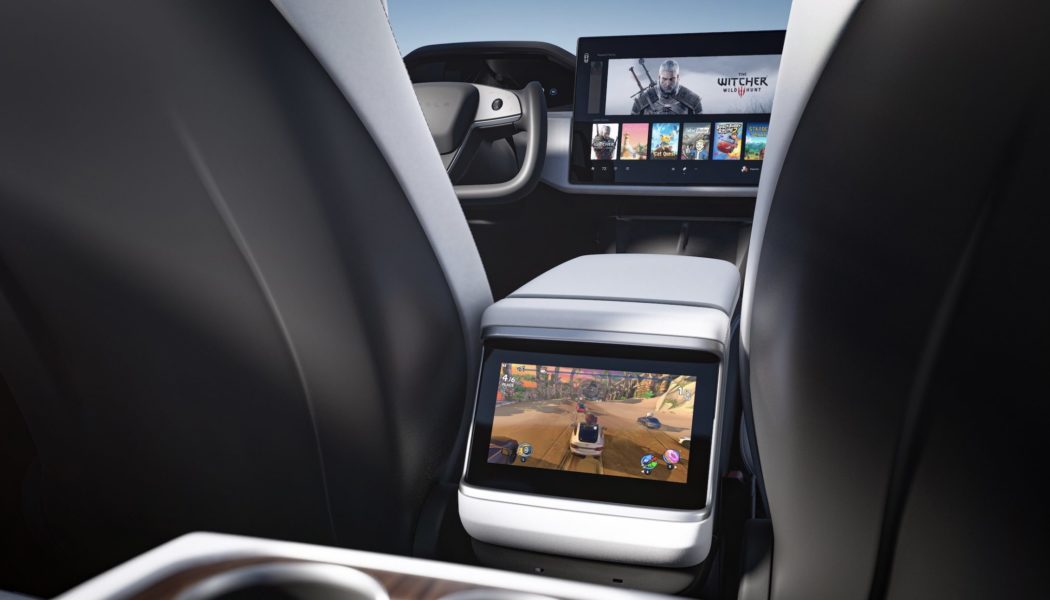During Computex 2021 (aka Taipei International Information Technology Show), AMD disclosed it is providing APU- and RDNA2-based GPUs to Tesla to use in its new Model S and Model X’s infotainment systems. That explains Tesla’s bold claims, noted on its website, that “[u]p to 10 teraflops of processing power enables in-car gaming on-par with today’s newest consoles” in its Model S and Model X vehicles. Essentially, Tesla is putting a gaming computer on wheels, but more importantly, it shows the company is doubling down on a smart-connected vehicle future.
The Hardware
The current MCU2 (the second-generation media control unit) found in all Tesla models on sale today uses an Intel Atom processor, which is a lower-end product usually found in budget laptops. This new chipset from AMD—some Tesla fans have dubbed it “MC3″—should be a major upgrade, and Tesla claims it will be in vehicles this month. The APU (a CPU with an integrated, lower-performance GPU) generally handles the media system, using less power to handle simple tasks. The high-power dedicated GPU kicks in for high demand applications such as AAA games.
According to an earlier leak from developer Patrick Schur on Twitter, this high-power chip is based on AMD’s Navi 23 GPU, which should put it more or less on par with Sony’s PS5 gaming console in terms of raw computing power. Since the new Tesla infotainment screen has a 2200 x 1300 resolution, gaming performance should be at least equivalent to a PS5 hooked up to a 4K (3840 x 2160) TV.
Overall, this new chipset from AMD is a huge leap from the old Intel chip; think of it like going from a $400 netbook to a $2,000 gaming laptop. However, this change to a higher end chipset may put Tesla in a slight manufacturing disadvantage for a while, as the current global microchip shortage and strong demand from both gamers and crypto miners means GPUs are scarce. The demand is far bigger than supply, and manufacturing can’t scale up quickly to accommodate the demand, so don’t expect this new chipset to trickle down to higher volume Teslas such as the Model 3 and Model Y any time soon.
(Speaking of crypto-mining, the AMD GPU should provide 40-60 MH/s—millions of hashes per second—for mining Ethereum, but don’t buy a Model S as a mining rig. At the current rate, profit is roughly $4 a day, you will need 20,000 days to reach ROI, unless you “diamond hands” hold and ETH moons someday. And it’s not like Tesla would let you install any mining software, anyway.)
The Software and Future Potential
Nerdy hardware talk aside, what does this new chipset bring to the in-car experience? A smoother infotainment UI should be the most noticeable benefit. The Intel Atom chip from 2018 has started to show its age as Tesla added more functions throughout the years; the in-car browser can’t even scroll smoothly on this site, motortrend.com. And entertainment features such as Netflix and YouTube UI have started to feel sluggish. The new chip will almost certainly improve the UI experience.
Being able to run AAA games—big-budget blockbuster video games, in other words—is a gimmick that helps sell an expensive car, but it’s a gimmick no other brand has attempted. But there is more to it below the surface: This highly capable hardware paves a path for extra revenue for Tesla in the future, should it decide to sell games and apps on its own platform. The gaming industry is worth $150 billion; Apple’s AppStore made an estimated $64 billion in 2020.
Tesla has the ability to reach a user base of over a million owners, so selling software and subscription features is a potential revenue stream that is difficult to ignore. When driver-assistance technology becomes more mature in the coming years, and drivers don’t have to monitor the road at all times, the in-car infotainment system may become the major feature for car buyers.
It took Apple’s iOS 13 years to build up a customer base capable of generating $64 billion in one year. Since Tesla is intent on developing true self-driving systems in the future, it makes sense to start thinking about how to lock their customer base into their software ecosystem.
Game Time
To see how the current MCU stacks up, we booted up some AAA games for an unscientific test. It worked … with a few caveats.
As mentioned above, due to chip shortage, don’t expect to play AAA games in the Model 3 and Model Y anytime soon. But what if you really wanted to play high-end games while waiting in line for an available Supercharger in a parking lot (stationary, absolutely NOT driving on the road), and you didn’t have the latest Model S or Model X? Well, Tesla’s in-car browser is based on Google’s Chromium—the open-source code that underpins Chrome and many other browsers—and Google has a game streaming service named Stadia, so in theory you can play AAA titles through the in-car browser.
I plugged in my Stadia controller to an in-car USB slot, opened up the browser and logged into my Stadia account. And … it worked. I was able to play Star Wars Jedi: Fallen Order on a Tesla Model 3’s screen.
But it didn’t work well. In fact, it was nigh-unplayable, due to frequent disconnects and numerous input lags. Game streaming requires a stable internet connection, and the car’s network module failed to provide that. Whether it was on full bar LTE cellular or a stable WIFI home internet, the MCU2 struggled to maintain a stable connection. Still, it works, in a technical sense, and the better internet module that will come with the MCU3 hardware improvements should bring Tesla’s dream of premium gameplay to a small screen near you.










